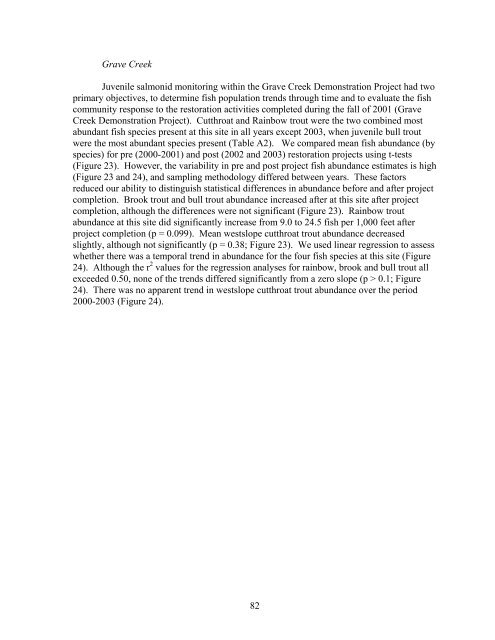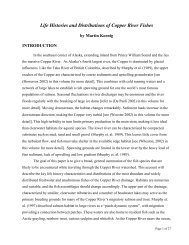Mitigation for the Construction and Operation of Libby Dam
Mitigation for the Construction and Operation of Libby Dam
Mitigation for the Construction and Operation of Libby Dam
Create successful ePaper yourself
Turn your PDF publications into a flip-book with our unique Google optimized e-Paper software.
Grave Creek<br />
Juvenile salmonid monitoring within <strong>the</strong> Grave Creek Demonstration Project had two<br />
primary objectives, to determine fish population trends through time <strong>and</strong> to evaluate <strong>the</strong> fish<br />
community response to <strong>the</strong> restoration activities completed during <strong>the</strong> fall <strong>of</strong> 2001 (Grave<br />
Creek Demonstration Project). Cutthroat <strong>and</strong> Rainbow trout were <strong>the</strong> two combined most<br />
abundant fish species present at this site in all years except 2003, when juvenile bull trout<br />
were <strong>the</strong> most abundant species present (Table A2). We compared mean fish abundance (by<br />
species) <strong>for</strong> pre (2000-2001) <strong>and</strong> post (2002 <strong>and</strong> 2003) restoration projects using t-tests<br />
(Figure 23). However, <strong>the</strong> variability in pre <strong>and</strong> post project fish abundance estimates is high<br />
(Figure 23 <strong>and</strong> 24), <strong>and</strong> sampling methodology differed between years. These factors<br />
reduced our ability to distinguish statistical differences in abundance be<strong>for</strong>e <strong>and</strong> after project<br />
completion. Brook trout <strong>and</strong> bull trout abundance increased after at this site after project<br />
completion, although <strong>the</strong> differences were not significant (Figure 23). Rainbow trout<br />
abundance at this site did significantly increase from 9.0 to 24.5 fish per 1,000 feet after<br />
project completion (p = 0.099). Mean westslope cutthroat trout abundance decreased<br />
slightly, although not significantly (p = 0.38; Figure 23). We used linear regression to assess<br />
whe<strong>the</strong>r <strong>the</strong>re was a temporal trend in abundance <strong>for</strong> <strong>the</strong> four fish species at this site (Figure<br />
24). Although <strong>the</strong> r 2 values <strong>for</strong> <strong>the</strong> regression analyses <strong>for</strong> rainbow, brook <strong>and</strong> bull trout all<br />
exceeded 0.50, none <strong>of</strong> <strong>the</strong> trends differed significantly from a zero slope (p > 0.1; Figure<br />
24). There was no apparent trend in westslope cutthroat trout abundance over <strong>the</strong> period<br />
2000-2003 (Figure 24).<br />
82
















